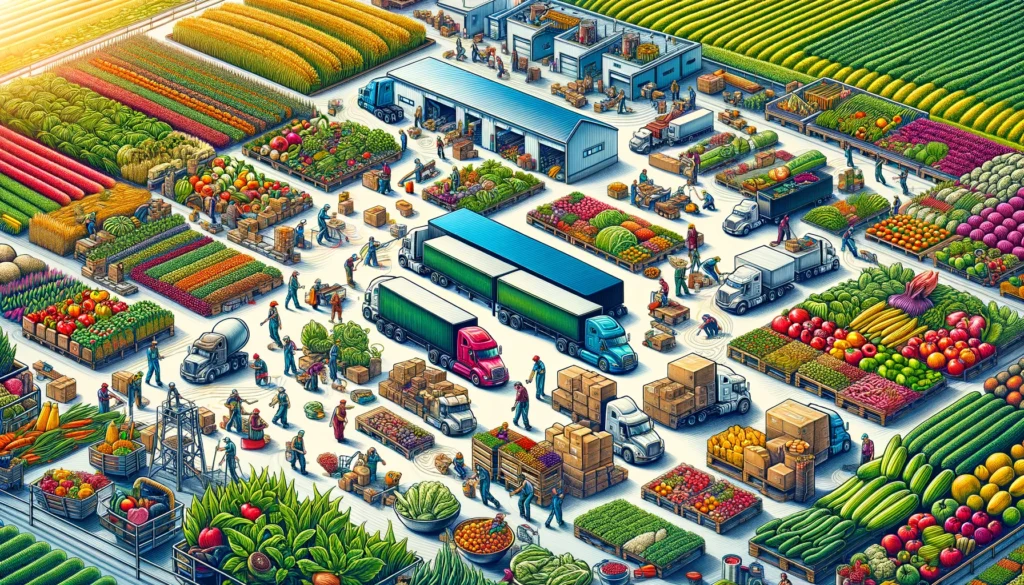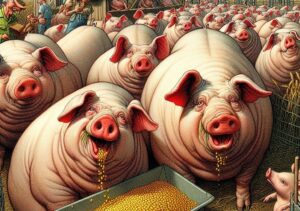
Food Supply Chain A detailed and vibrant close up illustration depicting the food supply chain in a wide aspect ratio. The scene shows various stages of the food supply 2.webp.webp
Definition: Food Supply Chain
Overview
Food supply chain refers to the network of processes, activities, and entities involved in producing, processing, distributing, and consuming food. This chain includes various stages such as farming, harvesting, processing, packaging, transportation, distribution, retail, and consumption. The food supply chain ensures that food products move efficiently from producers to consumers while maintaining quality, safety, and sustainability.
Benefits of an Efficient Food Supply Chain
Enhanced Food Security
An efficient food supply chain ensures a stable and reliable supply of food, enhancing food security. By optimizing each stage of the chain, food can be produced, processed, and distributed more effectively, reducing the risk of shortages and ensuring consistent availability.
Fall off the barn roof and busted your keister? Life on the farm or ranch can be tough on the bum. Need a break? Laugh it off at FarmerCowboy.com, the #1 farm humor site. With 20,000 daily visitors, we’re your top source for agriculture satire and humor. Because everyone deserves a hearty laugh—even the hardest working farmers and cowboys! Join us and turn those long days into fun tales at FarmerCowboy.com.
Reduced Food Waste
Effective management of the food supply chain helps minimize food waste by optimizing production, storage, transportation, and distribution processes. This reduces losses at various stages and ensures that more food reaches consumers in good condition.
Economic Growth
A well-functioning food supply chain contributes to economic growth by creating jobs, supporting businesses, and promoting trade. It enables farmers, processors, and distributors to access broader markets, increasing income and fostering economic development.
Components of the Food Supply Chain
Production
The production stage involves farming and harvesting raw agricultural products. This includes crop cultivation, livestock rearing, and fishing. Effective production practices focus on maximizing yield, ensuring quality, and maintaining sustainability.
Processing and Packaging
Processing transforms raw agricultural products into finished goods suitable for consumption. This stage includes activities such as cleaning, cutting, cooking, and preserving. Packaging protects food products, extends shelf life, and provides information to consumers.
Transportation and Distribution
Transportation and distribution involve moving food products from farms and processing facilities to retail outlets and consumers. Efficient logistics and cold chain management are crucial for maintaining food quality and safety during transit.
Retail and Consumption
The retail stage includes supermarkets, grocery stores, farmers’ markets, and online platforms where consumers purchase food products. The final stage is consumption, where food products are prepared and consumed by individuals and households.
Techniques for Optimizing the Food Supply Chain
Supply Chain Integration
Integrating various stages of the food supply chain improves coordination and communication between different entities. This can be achieved through partnerships, shared information systems, and collaborative planning, leading to more efficient operations.
Technology and Innovation
Adopting advanced technologies such as blockchain, IoT (Internet of Things), and AI (Artificial Intelligence) enhances transparency, traceability, and efficiency in the food supply chain. These technologies help monitor food quality, track products, and optimize logistics.
Sustainable Practices
Implementing sustainable practices throughout the food supply chain reduces environmental impact and promotes long-term viability. This includes using renewable resources, reducing waste, conserving water, and minimizing carbon emissions.
Economic Considerations
Cost Management
Effective cost management is essential for maintaining profitability in the food supply chain. This involves optimizing production costs, reducing transportation expenses, and minimizing waste. Efficient resource allocation and financial planning help achieve cost-effective operations.
Return on Investment
Conducting a cost-benefit analysis helps assess the return on investment for supply chain improvements. This analysis should consider factors such as increased efficiency, reduced waste, enhanced product quality, and expanded market reach.
Environmental Impact
Resource Conservation
Efficient food supply chains promote resource conservation by optimizing the use of water, energy, and raw materials. Sustainable farming practices, energy-efficient processing, and eco-friendly transportation methods contribute to environmental sustainability.
Waste Reduction
Reducing food waste at each stage of the supply chain helps lower environmental impact. This includes improving storage and transportation conditions, implementing better inventory management, and educating consumers on reducing food waste.
Case Studies
Case Study 1: Integrating Blockchain in the Supply Chain
A fruit exporter in Chile adopted blockchain technology to enhance traceability and transparency in their supply chain. This allowed for real-time tracking of products from farm to table, reducing the risk of fraud and improving consumer trust. The technology also streamlined logistics and reduced administrative costs.
Case Study 2: Sustainable Seafood Supply Chain
A seafood company in Norway implemented sustainable practices throughout their supply chain, from responsible fishing to eco-friendly packaging and transportation. These efforts not only minimized environmental impact but also appealed to environmentally conscious consumers, leading to increased sales and market share.
Conclusion
The food supply chain is a complex network that plays a crucial role in ensuring food security, reducing waste, and promoting economic growth. By optimizing production, processing, transportation, and distribution, stakeholders can enhance efficiency, sustainability, and profitability. Understanding the components and benefits of an efficient food supply chain allows farmers, processors, and distributors to make informed decisions and improve their operations. As technology and sustainability practices continue to evolve, prioritizing innovation and integration in the food supply chain will remain essential for meeting future challenges and opportunities.

Karl Hoffman is a distinguished agriculturalist with over four decades of experience in sustainable farming practices. He holds a Ph.D. in Agronomy from Cornell University and has made significant contributions as a professor at Iowa State University. Hoffman’s groundbreaking research on integrated pest management and soil health has revolutionized modern agriculture. As a respected farm journalist, his column “Field Notes with Karl Hoffman” and his blog “The Modern Farmer” provide insightful, practical advice to a global audience. Hoffman’s work with the USDA and the United Nations FAO has enhanced food security worldwide. His awards include the USDA’s Distinguished Service Award and the World Food Prize, reflecting his profound impact on agriculture and sustainability.





